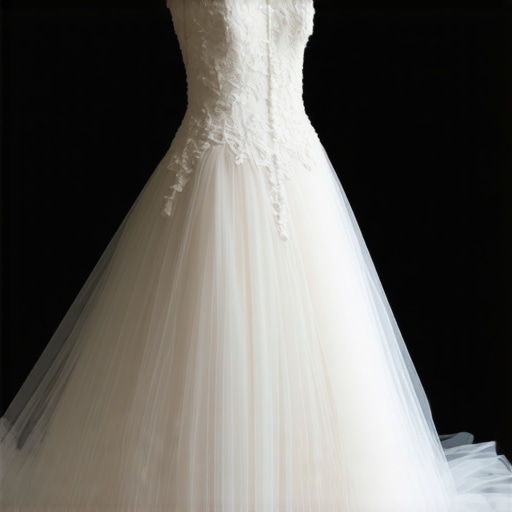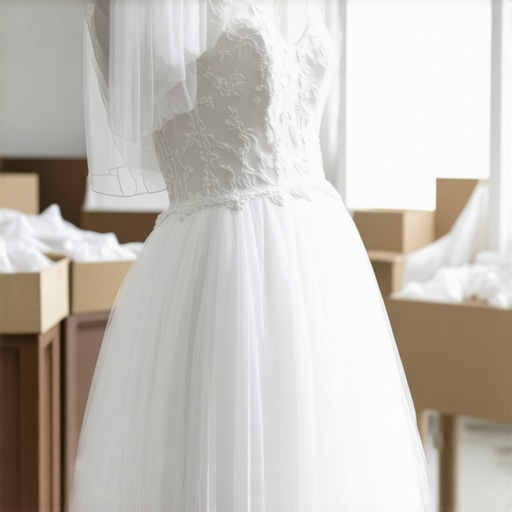My Journey to Preserving a Wedding Gown That Lasts a Lifetime
When I got married last year in Tampa Bay, I knew I wanted my wedding dress to be more than just a fleeting memory. I was fortunate enough to discover the importance of museum-quality wedding gown preservation and how it can protect my gown for decades to come. That decision not only kept my dress pristine but also became a cherished family heirloom I plan to pass down someday.
Why Is Museum-Quality Preservation So Crucial?
Having my wedding gown preserved at a professional, high-standard facility in Tampa Bay made all the difference. Unlike regular cleaning, museum-quality preservation involves meticulous cleaning, expert handling, and special storage techniques that prevent yellowing, fabric deterioration, and stain setting. I learned that such preservation is essential for delicate fabrics like lace, satin, and vintage materials that require expert care.
How Do You Choose the Right Preservation Service?
Choosing a professional service can seem overwhelming, but I found that looking for certifications, experience, and client reviews are vital. I also contacted local Tampa Bay specialists who specialize in expert wedding dress cleaning services. They explained that the best preservation includes gentle stain removal, fabric-specific cleaning, and custom acid-free storage boxes designed for long-term protection.
What Are the Long-Term Benefits of Proper Gown Preservation?
Proper preservation ensures that your gown maintains its original beauty, color, and fabric integrity for future generations. I read an authoritative article by the Bridal Association that emphasizes how museum-quality techniques extend the life of your gown and preserve its sentimental value. It’s a worthwhile investment, especially if you plan to keep the dress for future anniversaries or family history.
Is It Really Worth Investing in Museum-Quality Preservation?
Absolutely! As someone who values family legacy and heirlooms, I believe that professional preservation is an investment in your memories. It’s worth every penny to ensure that your gown remains as stunning as the day you wore it. Plus, many services now offer convenient options for urgent same-day cleaning and preservation if needed.
If you’re curious about how to start, I recommend reaching out to local Tampa Bay experts and asking about their preservation processes. You might be surprised how much a professional can do to protect your beautiful dress.
Have you preserved your wedding gown, or are you considering it? Share your experiences or questions in the comments below—I’d love to hear your story!
Understanding the Nuances of Fabric Care for Timeless Preservation
One of the most overlooked aspects of wedding gown preservation is understanding the specific fabric composition of your dress. Whether your gown features delicate lace, satin, tulle, or vintage silk, each material demands a tailored cleaning approach to avoid damage. For instance, vintage fabrics like silk charmeuse or lace require gentle, specialized cleaning techniques that prevent fibers from weakening or yellowing over time. Consulting with a preservation expert ensures that your gown receives the appropriate care, preserving its original texture and color for decades.
How Do Experts Handle Stains and Fabric Aging?
Stain removal without compromising the fabric is a delicate process. Professionals use advanced techniques such as solvent-based cleaning or enzyme treatments, which are effective yet gentle. Additionally, they assess the age and condition of the gown to determine if pre-treatment is necessary to prevent further deterioration. It’s also vital to consider environmental factors—such as humidity, light exposure, and storage conditions—that can accelerate fabric aging. Proper storage in acid-free, breathable containers, combined with climate control, significantly prolongs the gown’s pristine condition. For more insights, explore museum-quality preservation techniques.
What Are the Challenges of Preserving Vintage or Heirloom Gowns?
Vintage or heirloom wedding dresses present unique preservation challenges due to their age and fragility. Fabrics like antique silk or hand-made lace can be more susceptible to deterioration, discoloration, or tearing. Experts often recommend testing small fabrics before full cleaning, using low-moisture or dry cleaning methods, and employing special preservation boxes with UV protection. These steps help prevent common issues like fabric yellowing or mold growth, ensuring that your treasured heirloom remains intact for future generations. If you’re considering restoring or preserving a vintage gown, seek out specialists experienced in vintage textiles, such as those highlighted in vintage gown cleaning experts in Tampa.

Can Preservation Extend Beyond the Dress to Accessories?
Absolutely. Many brides overlook the importance of preserving accessories like veils, gloves, or intricate embroidery details that accompany their gown. These items often require different cleaning and storage techniques to prevent fading, tarnishing, or fabric damage. Professional preservation services can offer comprehensive care, ensuring every element of your bridal ensemble is protected. This holistic approach not only maintains aesthetic harmony but also maximizes the sentimental value of your wedding collection. To learn more about caring for vintage accessories, visit expert accessory preservation tips in Tampa.
Are You Ready to Safeguard Your Wedding Memories?
If you’re contemplating future preservation or need guidance on the right services, consulting with local Tampa Bay specialists can make a significant difference. They can perform detailed assessments, provide custom storage solutions, and offer expert advice tailored to your gown’s specific fabric and age. Remember, investing in professional preservation isn’t just about protecting fabric; it’s about safeguarding your cherished memories for generations to come.
Feeling inspired to start your gown’s preservation journey? Reach out to trusted experts and ask about their techniques, certifications, and success stories. Your wedding dress is more than fabric; it’s a symbol of your love story, deserving the best care possible. Share your thoughts or ask questions in the comments—I love hearing about your preservation plans!
Unlocking the Hidden Nuances of Long-Term Wedding Dress Care
As I delved deeper into the world of wedding gown preservation, I realized that understanding the subtle nuances of fabric aging and environmental factors can significantly impact the longevity of your dress. One personal lesson I learned was how even minor fluctuations in humidity and temperature could accelerate fabric deterioration. This insight came after witnessing a vintage gown that had yellowed prematurely due to inconsistent storage conditions.
Personal Reflections on Vintage Fabric Challenges
Preserving vintage or heirloom gowns requires more than just standard cleaning techniques; it demands a tailored approach that considers the fabric’s age and delicacy. For example, antique silk or lace often contains fibers that are more susceptible to yellowing and tearing. I found that consulting with specialists who are experienced in vintage textiles makes a world of difference, as they employ low-moisture or dry cleaning methods designed explicitly for fragile fabrics. This personalized care helps maintain the gown’s original texture and beauty, which I find deeply rewarding.
How Do Experts Handle Complex Stains Without Damage?
One of the most complex aspects of preservation is stain removal, especially with vintage fabrics where improper techniques can cause irreversible damage. In my experience, professionals use advanced solvent-based cleaning or enzyme treatments, but they also perform meticulous patch testing before proceeding. This cautious approach ensures stains are effectively removed without compromising the fabric’s integrity. According to a study by the Textile Conservation Society, such precision techniques can extend the lifespan of delicate textiles by decades, emphasizing the importance of choosing experienced preservationists. For brides considering preservation, I recommend asking potential service providers about their expertise with complex stains and vintage fabrics, as this can dramatically influence the outcome.
What Role Does Custom Storage Play in Maintaining the Dress’s Original State?
Custom storage solutions are often overlooked but are crucial for long-term preservation. I found that acid-free, breathable boxes with UV protection are essential to prevent yellowing, mold, and light damage. Additionally, storing the gown in a climate-controlled environment—away from direct sunlight and humidity fluctuations—can make a profound difference. I’ve personally invested in a custom preservation box with a soft, padded interior that supports the gown’s shape and prevents creasing. This experience taught me that tailored storage isn’t just about protection; it’s about respecting the gown’s fabric history and ensuring its beauty endures for generations.
How Can Brides Prepare Their Dresses for Future Restoration or Re-Dyeing?
Another nuanced aspect I’ve explored is how proper preservation can facilitate future restoration or even re-dyeing if needed. When a gown is preserved with care, it preserves not just the fabric but also the details like embroidery and beading, making future restoration more feasible. I recommend brides consult with preservation experts about potential re-dyeing options, especially if the gown has yellowed over time. A well-preserved dress can serve as a canvas for future customization, allowing it to adapt to evolving fashion tastes or sentimental desires. This layered approach to preservation underscores its role as an investment in the dress’s entire lifecycle.
Are Your Wedding Memories as Precious as Your Dress?
Reflecting on my journey, I realize that preservation isn’t just about protecting fabric; it’s about safeguarding memories, love stories, and family legacies. If you’re contemplating professional preservation, I encourage you to seek out specialists who understand these deeper nuances. Sharing your story and asking questions about their techniques can help ensure your gown receives the care it truly deserves. Have you explored advanced preservation techniques or faced challenges with vintage dresses? I’d love to hear your experiences and insights—please share in the comments or reach out through my contact page. Remember, your wedding gown is more than fabric; it’s a treasured piece of your life’s story, deserving of the most thoughtful care.
Mastering the Art of Vintage Fabric Restoration and Preservation
Preserving vintage wedding gowns extends beyond routine cleaning; it involves an intricate understanding of historical fabrics, craftsmanship, and the subtle signs of aging that can compromise delicate textiles. Having personally navigated the challenges of restoring a 19th-century lace gown, I learned that employing low-moisture dry cleaning and utilizing specialized conservation techniques tailored for antique fibers are essential. These methods, often recommended by certified textile conservators such as those affiliated with the American Institute for Conservation, help maintain the gown’s original textures and prevent further deterioration. Understanding the unique composition of vintage fabrics, like silk organza or hand-stitched lace, allows preservationists to select the most appropriate treatment, ensuring the gown’s legacy endures for generations.
How Do Experts Address Complex Stains on Fragile, Timeworn Fabrics?
Handling stains on vintage or heirloom dresses presents significant difficulties, as improper removal can cause irreparable damage. I discovered that professionals use a combination of gentle solvent-based solutions and enzyme treatments precisely matched to the stain type and fabric age. For example, a delicate tea stain on a silk gown was treated with a carefully applied enzyme wash that dissolved the organic residue without weakening the fibers. Additionally, meticulous patch testing and microscopic inspection are standard procedures to prevent discoloration or fiber breakage, as emphasized by conservation specialists. This careful approach is vital to restoring the beauty of historical gowns while respecting their fragile condition.
What Role Do Climate-Controlled, Custom Storage Solutions Play in Long-Term Preservation?
Effective storage is arguably as important as expert cleaning in maintaining a vintage gown’s condition. I invested in a custom-built, acid-free storage box with UV-filtering glass and climate control features that regulate humidity and temperature. These measures prevent yellowing, mold growth, and fiber degradation, especially crucial for textiles with antique silk or delicate lace. Regularly monitoring storage conditions and ensuring minimal light exposure significantly prolongs the gown’s lifespan. According to a comprehensive guide by the Textile Museum, tailored storage solutions that consider fabric type and historical context are indispensable for lasting preservation, transforming a fragile heirloom into a future family treasure.
Can Preservation Techniques Facilitate Future Re-Dyeing or Restoration?
Interestingly, well-executed preservation can lay the groundwork for future re-dyeing or restoration efforts. By maintaining the fabric’s structural integrity and preventing yellowing, preservation specialists create a reversible, stable environment that allows for delicate re-coloring if desired. For instance, if a vintage gown has yellowed over time, a professional re-dyeing process—performed with precision—can restore its original hue without damaging the fabric. This flexibility underscores the importance of choosing preservation methods that prioritize reversibility and minimal invasiveness, ensuring the gown remains adaptable to future sentimental or aesthetic changes. It’s a nuanced aspect that underscores preservation’s role as a long-term investment in sentimental value.
Are there emerging technologies or innovative practices revolutionizing vintage gown preservation?
Absolutely. Recent advancements such as laser cleaning and nanotechnology-based protective coatings are beginning to transform textile conservation. Laser cleaning allows precise removal of surface deposits and stains without physical contact, minimizing fiber stress. Meanwhile, nanocoatings provide a breathable, protective barrier against environmental pollutants and microbial growth. These cutting-edge techniques, supported by research from institutions like the Textile Conservation Research Group, are poised to enhance the longevity of vintage textiles significantly. Engaging with specialists who incorporate these innovations can provide an extra layer of security for your heirloom gown. If you’re interested in exploring these options further, I recommend consulting with preservation experts who stay at the forefront of textile science and conservation.
If you’re passionate about safeguarding your vintage or heirloom wedding gown, I encourage you to delve deeper into these advanced preservation strategies. Sharing your experiences or questions can help foster a community of informed brides and collectors dedicated to heritage preservation. Feel free to reach out through my contact page or leave a comment below—I’m eager to discuss and exchange insights on maintaining these priceless symbols of love and history for generations to come.
Things I Wish I Knew Earlier (or You Might Find Surprising)
1. The Fabric Matters More Than You Think
When I first considered wedding gown preservation, I underestimated how different fabrics require unique care. Vintage lace, silk, and satin each have their quirks. I learned that consulting with a specialist who understands these nuances can prevent costly mistakes and ensure your dress stays beautiful for decades.
2. Stain Removal Is a Delicate Art
Removing stains from delicate fabrics is not as simple as dabbing with water. I was amazed to discover that gentle, fabric-specific cleaning techniques, often involving enzymes or solvents, make all the difference. This knowledge made me appreciate the craftsmanship behind professional preservation.
3. Proper Storage Is an Art Form
Storing your dress in acid-free, breathable boxes with UV protection is crucial. I once stored mine in a regular box, only to find it yellowed over time. Investing in custom preservation solutions has been a game-changer for maintaining its original beauty.
4. Vintage Gowns Need Extra Love
Preserving vintage or heirloom dresses is more challenging but incredibly rewarding. Low-moisture cleaning and specialized conservation techniques help protect fragile fibers. If you’re lucky enough to inherit a family gown, seeking out experts in vintage textile care is essential.
5. Accessories Deserve Attention Too
Veils, gloves, and embroidery details also need professional care. I realized that holistic preservation of your bridal ensemble enhances its sentimental and aesthetic value for future generations.
6. Future Re-Dyeing Is Possible with Good Preservation
Well-preserved fabrics can be re-dyed or restored later. I find this fascinating because it means your gown can adapt to future sentimental needs or fashion trends, making preservation a long-term investment.
Resources I’ve Come to Trust Over Time
American Institute for Conservation: Their expertise in textile conservation is unparalleled and helped me understand the importance of choosing certified professionals. This site is a treasure trove for anyone serious about preservation.
The Textile Museum: They offer comprehensive guides on fabric care and preservation techniques that I found invaluable. Their insights made me more confident in selecting the right services. Check them out here.
Bridal Association of America: Their articles on long-term preservation and heirloom care helped me understand the emotional value behind preserving a wedding gown. I recommend their resources for any bride wanting to protect her memories.
Parting Thoughts from My Perspective
Reflecting on my journey, I realize that wedding gown preservation is both an art and a science. It requires attention to detail, expert guidance, and a touch of patience. The effort I invested has paid off in the form of a gown that still looks stunning years later, serving as a tangible reminder of my special day. If you’re considering preserving your gown, I encourage you to seek out reputable specialists who understand the nuances of fabric care and long-term storage. Your wedding dress isn’t just fabric; it’s a symbol of love, family, and memories worth safeguarding. If this resonated with you, I’d love to hear your thoughts or experiences—feel free to share in the comments or contact me directly. Let’s keep these beautiful stories alive for generations to come.

